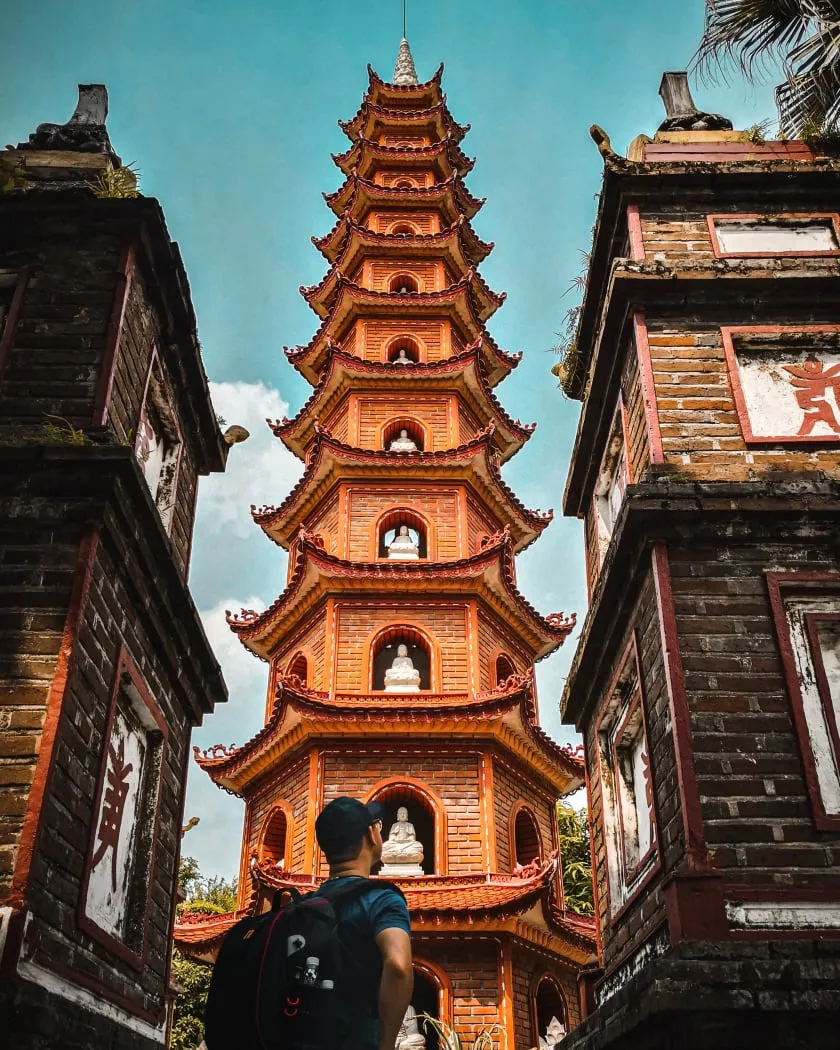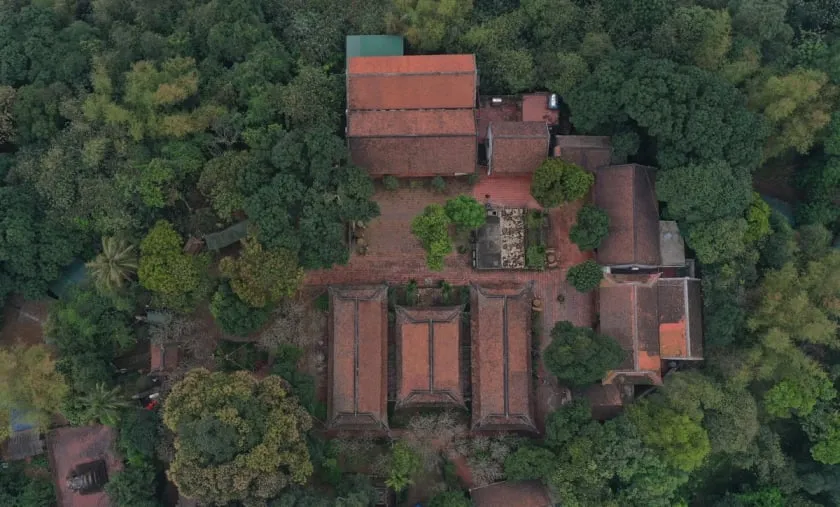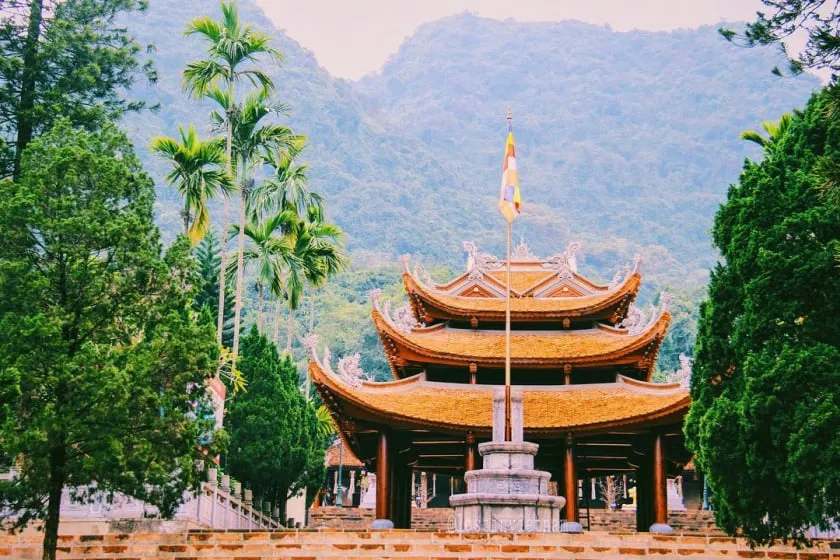Vietnam, a land of ancient civilization, is not only famous for its breathtaking landscapes but also a sanctuary of ancient pagodas imbued with historical and Buddhist cultural imprints. These pagodas are not merely sacred places of worship but also historical witnesses, preserving the nation’s traditional cultural values. Join “Du lịch khắp thế gian” to explore the oldest pagodas in Vietnam, where time seems to stand still, allowing us to reconnect with our roots and feel the tranquility within our souls.
Dau Pagoda – Bac Ninh: Vietnam’s Oldest Pagoda
Dau Pagoda, also known as Dien Ung, Phap Van, or Co Chau Pagoda, is located in Thanh Khuong ward, Thuan Thanh town, Bac Ninh province. Construction started in 187 and was completed in 226, making Dau Pagoda considered the oldest pagoda in Vietnam, closely associated with the nation’s cultural and Buddhist history. In 1962, Dau Pagoda was honored as a national historical relic by the State, affirming its significant role in Vietnam’s cultural heritage.

Dau Pagoda is linked to the legend of Mother Buddha Man Nuong, who is worshiped at To Temple in Men village, Man Xa. Having undergone numerous renovations, especially in 1313 under the Tran dynasty, Dau Pagoda carries the marks of many dynasties. The most prominent is Hoa Phong tower, a testament to the development of Buddhist architecture throughout historical periods. Despite the erosion of time, Dau Pagoda retains its ancient and solemn beauty, a must-visit spiritual destination when in Bac Ninh.
Tran Quoc Pagoda – Hanoi: Buddhist Symbol in the Heart of the Capital
Located on a small island on the East of West Lake, Tran Quoc Pagoda is one of the oldest pagodas in Hanoi and Vietnam. Built during the reign of King Ly Nam De (544 – 548), Tran Quoc Pagoda was once the Buddhist center of Thang Long capital during the Ly – Tran dynasties. With its prime location and unique architecture, Tran Quoc Pagoda is not only a spiritual destination but also an attractive tourist spot for both domestic and international visitors.

The architecture of Tran Quoc Pagoda resembles a blooming lotus flower, with interconnected layers in the shape of the Chinese character “工” (Cong). In 2003, the 15m-high Luc Do Dai Sen Stupa was inaugurated, further enhancing the pagoda’s majesty and splendor. Visiting Tran Quoc Pagoda, tourists not only admire unique architectural works but also immerse themselves in a peaceful space, finding inner peace.
Tay Phuong Pagoda – Hanoi: Museum of Buddhist Art Statues
Tay Phuong Pagoda, officially known as Sung Phuc Tu, is located on the peak of Cau Lau hill, Yen village, Thach Xa commune, Thach That district, Hanoi, about 40km from the city center. Although there is no definitive evidence of its construction date, many historical sources suggest that Tay Phuong Pagoda dates back to the Mac dynasty. Despite numerous renovations and name changes, Tay Phuong Pagoda still retains its ancient and unique architecture, especially the system of intricately carved Buddha statues.

Tay Phuong Pagoda is famous for its unique collection of Arhat statues, considered masterpieces of Vietnamese religious sculpture art. Each statue has a different face and posture, demonstrating the creativity and talent of ancient artisans. Visiting Tay Phuong Pagoda, tourists not only admire ancient architectural works but also discover a priceless treasure of national art.
Huong Pagoda – Hanoi: Pilgrimage to the Buddhist Land
Huong Pagoda, or Huong Son, is a Vietnamese cultural and religious complex, comprising dozens of Buddhist temples, shrines, and communal houses. The center of Huong Pagoda is located in Huong Son commune, My Duc district, Hanoi, along the Day River. The main pagoda is situated in Huong Tich cave, a sacred site attracting millions of Buddhists and tourists each year.

Huong Pagoda dates back to the 15th century and was built on a large scale in the late 17th century. After being destroyed in the war, the pagoda was restored from 1989. Visiting Huong Pagoda, tourists not only admire ancient pagodas but also immerse themselves in the beautiful natural scenery, explore mysterious caves, and participate in traditional festivals.

Thay Pagoda – Hanoi: Place Associated with Zen Master Tu Dao Hanh
Thay Pagoda is located at the foot of Sai Son mountain, in Sai Son commune, Quoc Oai district, Hanoi, about 20km from the city center. Initially, Thay Pagoda was just a small hermitage (Huong Hai hermitage) resided by Zen Master Tu Dao Hanh. Later, King Ly Nhan Tong ordered its reconstruction into two pagoda clusters: Cao Pagoda (Dinh Son Tu) on the mountain and Duoi Pagoda (Thien Phuc Tu) at the foot.

Thay Pagoda is not only famous for its unique architecture but also associated with the life and career of Zen Master Tu Dao Hanh, who made great contributions to teaching, healing people, and founding the water puppetry art. Visiting Thay Pagoda, tourists not only admire ancient architectural works but also learn about the history and culture of this land.
Conclusion
The oldest pagodas in Vietnam are not only unique architectural works but also invaluable cultural heritages, preserving the spiritual and historical values of the nation. Take the time to explore these pagodas, to feel the tranquility in your soul and better understand the cultural roots of the country. “Du lịch khắp thế gian” hopes that through this article, you will have more suggestions for your journey to discover the spiritual and cultural beauty of Vietnam.